Essential Surfing Tips for Beginners to Catch Waves
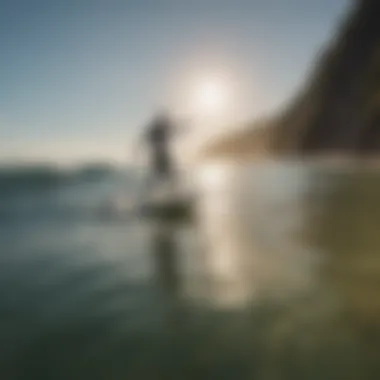
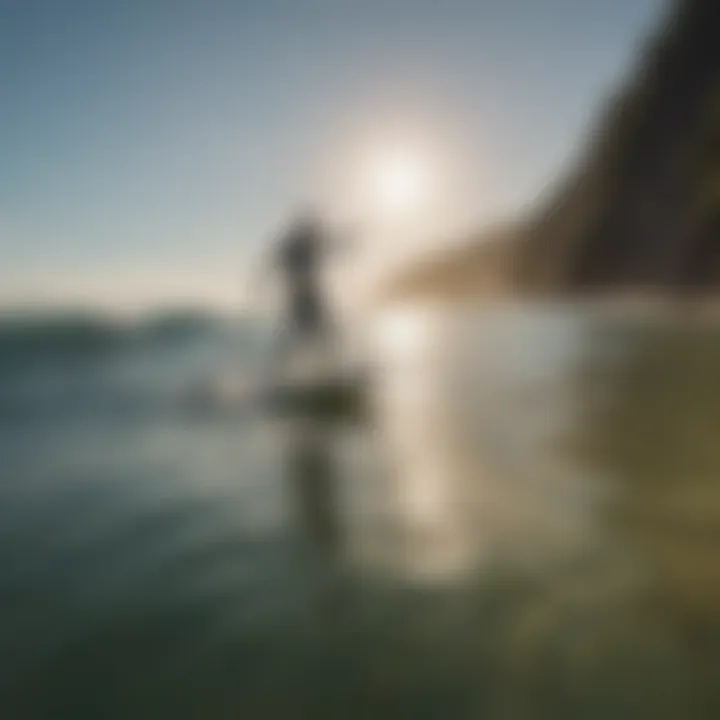
Intro
Surfing isn't just a sport; it’s a journey into the rhythm of the ocean. When you first dip your toes into the waves, a world of excitement and challenge awaits. Yet, this delightful adventure can seem daunting. With the right guidance and a solid understanding of the fundamentals, beginners can navigate the learning curve effectively.
As you embark on your surfing journey, the essence of this article lies in breaking down the barriers that may hinder your progress. It encompasses crucial aspects such as equipment selection, foundational techniques, and mental preparation. Each of these elements plays a significant role in not only improving your skills but also in cultivating a deeper appreciation for the waves and the environment around you. We aim to equip you with the knowledge and confidence to ride the waves while feeling safe and connected to the ocean.
What's Ahead
Expect detailed insights on gear essentials, practical techniques, and safety measures that will support you in the early stages of learning to surf. From selecting the right surfboard to mastering paddling techniques, every tip is designed with your success in mind. Furthermore, we will delve into the psychological component of surfing, addressing how to conquer fears and bolster your confidence on the board. So, grab your wetsuit, it's time to dive in!
Preface to Surfing
Surfing stands as a gateway to an exhilarating blend of adventure and tranquility. For many beginners, the journey into surfing is not merely about riding waves; it is a profound exploration of nature, oneself, and the spirit of the ocean. Diving into surfing opens doors to a lifestyle deeply entwined with respect for the sea and its rhythms. This article seeks to usher novices into that world, equipping them with essential knowledge and skills.
Surfing has a unique charm. It offers physical benefits, such as improved fitness and coordination, but also mental advantages like stress relief and a sense of accomplishment. As novices lace up their wetsuits and head to the shores, a wealth of factors must be considered. From understanding the ocean's behavior to the types of boards available, each element calls for thoughtful attention to maximize the surfing experience.
Historical Context
Surfing holds a rich heritage that traces back to ancient Polynesian culture. The first documented surfers hailed from the islands of Hawaii, where the locals mastered the art of riding waves as far back as the 12th century. With wooden boards carved from trees, they not only engaged in recreation but also demonstrated their respect for the ocean.
Later, surf culture spread to California in the early 1900s, dramatically influencing beach culture in America. The invention of foam boards, in the latter half of the 20th century, transformed surfing into a more accessible sport. Surfing's history is not just about wave-riding; it reflects cultural exchanges, technological advancements, and the evolution of social norms. Understanding this context helps beginners appreciate their place within a larger narrative.
The Appeal of Surfing
What makes surfing so captivating? The allure is multifaceted:
- Connection to Nature: There's an undeniable bond formed with the ocean. Riding waves fosters an appreciation for the natural world and encourages environmental stewardship.
- Community: Surfing is often more than a solo endeavor; it creates a sense of belonging. Surfers share techniques, tips, and stories that forge friendships and build local communities.
- Personal Growth: Every ride is a lesson in persistence and patience, enhancing one's mental fortitude. Learning to surf can be daunting; yet, with every tumble and successful stand, a powerful sense of achievement arises.
"The best surfer out there is the one having the most fun."
Each wave is a reminder that every journey in surfing is distinct and personal, making it not just a sport but an enjoyable lifestyle.
Understanding the Ocean
Grasping the fundamentals of the ocean is paramount for any surfer, especially beginners. It serves as the canvas upon which you’ll paint your surfing journey. You can pick the right surfboard or wear the best wetsuit, but if you don’t understand the ocean’s moods, you might find yourself floundering before you’ve even stood up on your board.
Wave Formation and Types
Waves are the heartbeat of the ocean, their formation is dictated by the wind, the seafloor topography, and even the boundless energy from storms. An understanding of wave types—like beach breaks, point breaks, and reef breaks—can drastically improve your experience.
- Beach Breaks: Waves that break over sandy bottoms, providing a more forgiving introduction to surfing for newcomers.
- Point Breaks: Waves that break over a point, offering smooth rides but often requiring more skill to navigate.
- Reef Breaks: These tend to be more powerful and can be hazardous, thus recommended only for more experienced surfers.
Learning to spot waves on the horizon and predict their behavior can make a world of difference. One key takeaway is the way a wave builds up. From the moment it's generated by wind, to traveling across the ocean, and finally spilling over as it reaches shallower waters—each stage has its own characteristics that you need to read and respond to.
"A surfer who knows the waves and understands their stance is halfway to riding them."
Tides and Currents
The ocean isn’t a static body of water; it’s constantly shifting due to gravitational pulls, leading to tides that can dramatically alter your surfing conditions. Tides can affect wave size, frequency, and even the quality of breaks.
- High Tide: Can lead to faster waves that might close out, making them less favorable for beginners.
- Low Tide: Often reveals more sandbanks and offers better opportunities for surfing, as waves might break more consistently.
Currents, such as rip currents, are another factor to keep in mind. Understanding how to identify and react to these powerful flows is crucial for safety.
Reading the Surf Report
Now, you might think reading a surf report is just a chore; however, it’s one of the essential tools in your surfing arsenal. A surf report provides valuable info on wave height, swell direction, wind speed, and tide times.
Most reports will include:
- Swell Size: Measured in feet, indicating the height of the waves.
- Swell Period: The time between waves; longer periods often mean better quality waves.
- Wind Conditions: Offshore winds can clean up the waves, while onshore winds can mess them up.
Being able to digest this info means you can choose when to hit the water for the best potential conditions. Platforms like Reddit and Facebook usually host local communities where surfers share real-time updates on conditions.
Understanding the ocean isn’t just about riding waves; it’s about surf awareness that can make or break your experience in the water.
Selecting the Right Surfboard
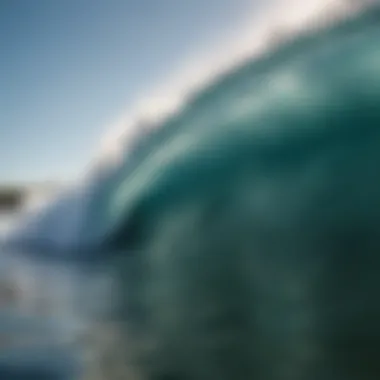
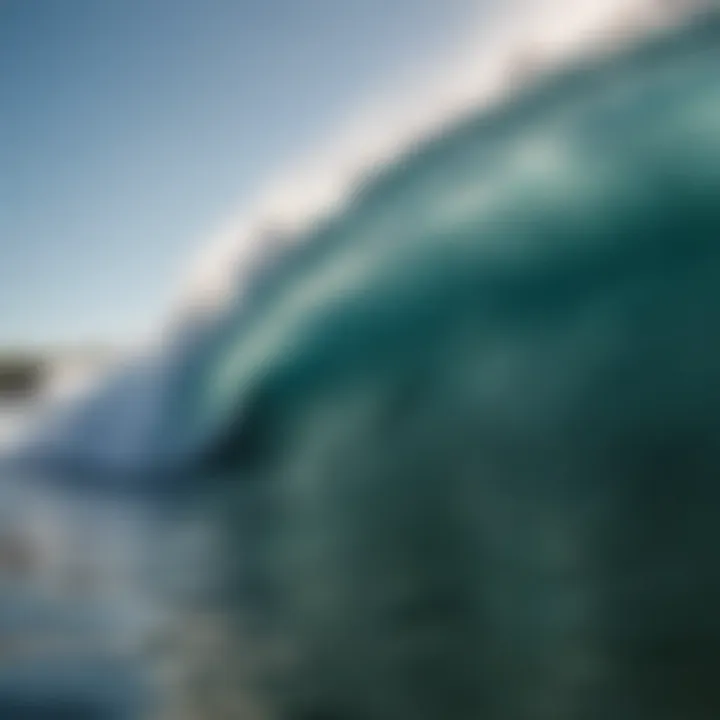
Choosing the right surfboard is critical for beginners. The board can make or break the surfing experience. A well-selected surfboard not only boosts your confidence but also enhances your learning curve. Choosing the wrong board might result in constant wipeouts and frustration, leaving a bad taste in your mouth about the sport. Thus, understanding your options and needs is essential.
When selecting a surfboard, consider factors like your height, weight, and skill level. A beginner usually benefits from a larger, more stable board. Stability leads to confidence, which, in turn, reflects on the waves you ride.
Types of Surfboards
Surfboards are not one-size-fits-all. They come in various shapes and sizes, each offering a unique experience.
- Shortboards: These are typically under 7 feet and are designed for agility. They’re mainly aimed at intermediate to advanced surfers.
- Longboards: Ranging from about 8 to 12 feet, longboards offer more stability and are perfect for beginners. They provide a great platform for learning the basics.
- Fishboards: Shaped like a fishtail, these boards are shorter and wider, offering a unique surf experience. They are versatile but may not be the best option for newbies.
- Stand-Up Paddleboards (SUPs): These boards are wider and designed for paddleboarding but can also be used for surfing. They are stable and perfect for a chilled day on gentle waves.
Each type has its own perks. Understanding their distinctions will help you find which suits your style.
Choosing Based on Skill Level
Skill level plays a pivotal role in surfboard selection. Beginners should focus on a surfboard that offers stability and ease of paddling. Here's what you should keep in mind:
- Beginner: Go for a longboard or a soft-top board. These are forgiving and great for catching waves easily.
- Intermediate: Depending on your progress, a fish or a shortboard could be a good fit. These boards are responsive and allow for more advanced maneuvers.
- Advanced: Shortboards are great for performance, allowing for tricks and speed. If you’ve mastered the basics, this might be your next step.
By choosing appropriately, you can ensure a smoother transition through your surfing journey.
Surfboard Maintenance
Just like any other piece of equipment, your surfboard needs maintenance. Here are some crucial tips:
- Rinse after use: Always rinse your board to remove saltwater. Salt can damage the board and make it heavy.
- Check for dings: Regularly inspect your board for any damage. If you spot a crack or a ding, get it repaired quickly to avoid deeper issues.
- Store properly: Keep your board out of the sun when not in use. UV rays can weaken the material and lead to warping.
- Use a board bag: When transporting your board, place it in a padded bag to prevent scratches and dents.
By keeping your board in top shape, you extend its lifespan and improve your performance in the water.
Essential Surfing Gear
Getting the right gear is not just a matter of style—it's essential for comfort, safety, and performance while surfing. For beginner surfers, understanding what equipment is necessary can make all the difference in having a successful and enjoyable day in the water. Knowing what to invest in helps prevent injuries and enhances overall surfing experience.
Wetsuits and Rash Guards
When it’s all said and done, wearing the right attire can make or break your day in the waves. Wetsuits provide thermal insulation, buoyancy, and protection. Depending on where you surf, a full suit, shorty, or even just a top might be all you need. If you're in a place where the water is frigid, like Northern California, investing in a thicker wetsuit is crucial. On the flip side, if you're soaking in waters around Hawaii, a shorty or even a surf shirt could do the trick.
On the other hand, rash guards serve a dual purpose. They offer UV protection, which is vital for your skin when you’re out under the blazing sun for hours. They also prevent the dreaded board rash that can occur when your skin rubs against the board while paddling out. Choosing a snug fit and lightweight material ensures freedom of movement. In regions with highly variable temperatures, consider layering—worn under a wetsuit, rash guards can improve comfort while also keeping you warm.
Safety Equipment
While the thrill of catching waves is enticing, safety must take center stage. A personal floatation device or PFD is a good idea, particularly for beginners who might struggle with paddling in a rough ocean. Some surfers opt for a surf leash, connecting their board to their ankle—this prevents the board from getting too far from you during a wipeout.
Additionally, using a surf helmet can provide protection against head injuries from falls or unexpected collisions with other surfers or their boards. Whether you’re surfing on a quiet lake or a wild ocean, having safety gear gives you peace of mind to focus on the fine art of riding waves.
"In surfing, it's often said, 'Safety first, fun second.' A little preparation goes a long way in ensuring a great day out on the water."
Accessorizing Your Gear
Now that you got the essentials sorted, what about the little things? Accessories can enhance your experience and comfort level in the water. For instance, surf booties work wonders if you’re in rocky areas or chilly waters. They provide grip and keep your feet warm. On hot days, consider a surf cap to shield your head from sunburn.
Some surfers swear by the importance of good sunglasses—even polarized ones—while others prefer water-resistant sunscreen to keep pesky UV rays at bay.
Investing in a quality board bag helps protect your board from dings and scratches when transporting it, ensuring it stays in prime condition for those perfect surf days.
As you get acclimated to surfing and begin to learn the ropes, observe what fellow surfers seem to find useful and what works well for your surfing style. Everyone's different, and finding the right combination will tailor your surfing to better complement your lifestyle.
Make it your own, and remember—the right gear is an investment in your surfing future.
Techniques for Beginners
When it comes to surfing, mastering the basic techniques is like laying the foundation for a sturdy house. The importance of getting these techniques right cannot be overstated. For beginners, these fundamental skills ensure not only a smoother journey but also a more enjoyable experience in the water. Learning how to paddle, position oneself on the board, and stand up effectively are essential building blocks that can make or break your early days of surfing.
These techniques provide the necessary confidence and control, allowing new surfers to tackle waves with less trepidation. Moreover, they significantly enhance safety in the water. Understanding these concepts helps build a proper respect for the ocean and can prevent mishaps that lead to injury.
Let’s delve into those core skills that every beginner surfer should polish.
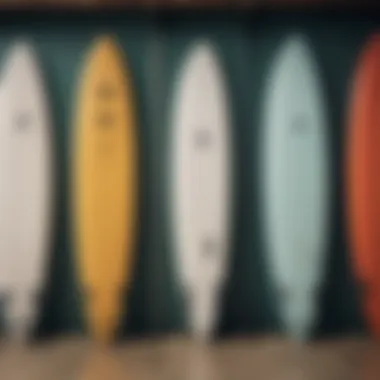
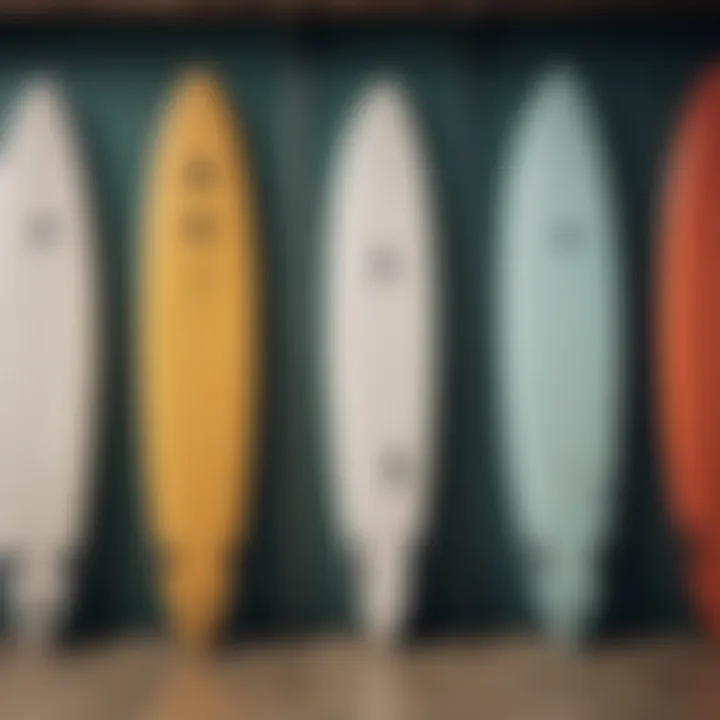
Paddling Basics
Paddling is often the first step into the world of surfing. It’s how you get to your wave and navigate the ocean, hence mastering it is vital. You might think it’s as easy as just flopping your arms around, but that’s far from the truth. Good paddling technique can drastically affect your performance.
Firstly, lie prone on your board with your body perfectly centered. This ensures minimal drag, helping you glide more efficiently through the water. Use your arms to paddle in a smooth, controlled manner. It’s key to maintain an alternate stroke; left, right, left, and so on. Think of it like swimming but with some extra finesse.
Don’t forget to keep your head up — this gives you a better view of approaching waves and other surfers. Also, practicing proper breathing while paddling gives you stamina for those long stretches in the lineup.
"Paddling is about rhythm and efficiency — get it right, and the waves will come to you."
Positioning on the Board
Now that you've got your paddling down, let’s talk positioning. Where you place your body on your surfboard directly affects your ability to catch waves. Being in the right spot means you can maximize your go-time on the wave and minimize wipeouts.
To find that sweet spot, think about balance. When paddling, your chest should be up, and your hips centered. A good rule of thumb is to keep your hips just above the mid-point of your board. This positioning can help you pivot easily when you’re ready to stand.
Also, each board might feel a tad different based on its size and shape. So, getting accustomed to how your specific surfboard reacts in water is crucial. This may take some trial and error, so don’t hesitate to spend time merely floating around before heading into bigger swells.
Standing Up Successfully
Standing up on your board can feel like trying to balance a flamingo on a tightrope — tricky, but not impossible. This skill is what really separates the newbies from the seasoned surfers, and with a bit of practice, you’ll be riding high in no time.
As you catch a wave, focus on your timing. You’ll want to pop up smoothly and quickly after you feel the wave lift you. Start by bringing your knees to your chest in a crouched position as the wave begins to propel you forward. This sets you up nicely for the next move.
Next, push off with your hands — like a spring — propelling yourself upward while rotating into a standing position. Your feet should land shoulder-width apart, centered between the rails of the board, to maintain stability. Avoid looking down at your feet; instead, look ahead to where you want to go.
These initial techniques are crucial in your surfing journey. Mastering them will not only lead to more successful rides but also create a deeper bond with the ocean's rhythm — an essential part of becoming a confident surfer.
Safety Considerations
Safety in surfing isn’t just a good practice; it’s a non-negotiable aspect of engaging with the ocean. Ensuring that you are aware of the risks and equipped with the right knowledge can prevent accidents and enhance your overall experience in the surf. From understanding the behaviors of waves to recognizing potential hazards, this topic is vital for anyone setting foot on a surfboard, especially beginners.
Ocean Safety Guidelines
Before diving into the waves, it’s crucial to arm yourself with the knowledge of ocean safety guidelines. These aren’t just suggestions; they are rules that can save lives. Here are fundamental points to keep in mind:
- Know the Weather and Surf Conditions: Always check the forecast. High winds and stormy weather can make conditions treacherous.
- Swim with a Buddy: It's safer to surf with someone. In case of trouble, you have help nearby.
- Stay Within Your Limits: Know your skill level and choose waves that match it. If you’re a beginner, small, gentle waves are your best bet.
- Wear Leash: Keeping your surfboard attached to you with a leash can prevent it from becoming a hazard to others.
These guidelines might seem straightforward, yet they often get overlooked in the excitement of anticipation. Remember, the ocean is unpredictable, and being prepared ensures you can focus on having fun.
Identifying Hazards
Surfing also comes with its own set of hazards that can sneak up on the unaware. Here’s how to spot potential dangers in the water:
- Riptides: Look for differences in wave patterns or color in the water. Riptides pull you out to sea and can be deceptive.
- Shallow Water: Always be aware of your surroundings. Surfing over rocky or shallow areas can lead to serious injuries.
- Marine Life: While most creatures are harmless, understanding local fauna helps in avoiding stings or bites.
"The sea, once it casts its spell, holds one in its net of wonder forever." - Jacques Cousteau
Always be mindful of your environment. Adopting an observant attitude towards your surroundings will serve you well.
Surfing Etiquette
Equally important is knowing how to behave in the lineup. Surfing etiquette helps maintain a respectful atmosphere and can prevent clashes between surfers. Here are some vital points:
- Take Turns: When you are at a popular spot, wait your turn to ride a wave. This is a common courtesy that everyone appreciates.
- Don’t Snake: Avoid paddling around someone who is already on a wave. It's not just poor form; it can lead to conflict and accidents.
- Respect Locals: If you are at a new surf spot, show respect to the local surfers. They often know the area best and will appreciate your decorum.
- Pick Up After Yourself: The ocean is great, but it won’t clean itself. Always pick up your trash to keep the environment pristine for everyone.
Grasping these guidelines creates a more enjoyable experience for both you and your fellow surfers, allowing everyone on the water to ride the waves in harmony.
The Psychological Aspect of Surfing
Surfing is not only about the physical act of riding waves; it also taps deeply into the psychological side of human experience. The thrill of the surf, coupled with the vastness of the ocean, often stirs complex feelings. Understanding these psychological elements can significantly enhance a beginner's experience and growth.
Overcoming Fear and Anxiety
Fear can be an ever-present shadow when learning to surf. New surfers often feel intimidated by the power of the waves and the depth of the ocean. This anxiety can be paralyzing, waiting on the beach, watching seasoned surfers carve through the swell can sometimes feel like an insurmountable challenge.
To tackle these fears, it’s crucial to approach the ocean with a mindset geared towards progression over perfection. Here are a few strategies to consider:
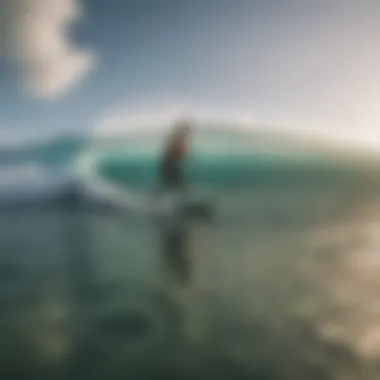
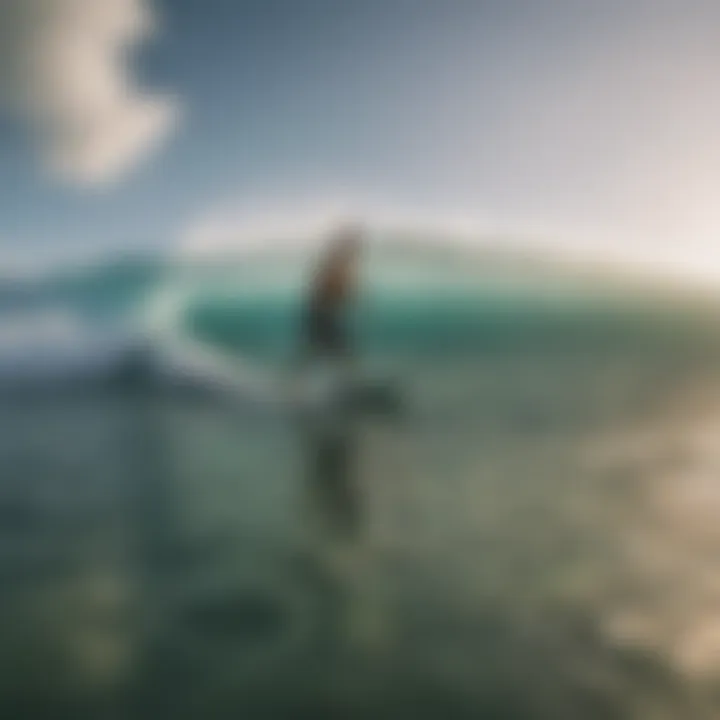
- Take small steps: Begin in shallow waters where the waves are gentler. Gradually work your way up to larger swells as comfort increases.
- Breathing techniques: Practicing deep breathing can help calm racing thoughts, making it easier to face anxiety head-on. It's funny how something so simple can help tremendously.
- Visualize success: Imagining yourself successfully catching and riding a wave can trick your mind into believing it is possible, which can make it a reality.
"The ocean is a friend and a teacher; it is important to listen to it, not just fear it."
Building Confidence on the Wave
Confidence is the secret sauce in surfing—without it, every wipeout can feel like a setback. However, building confidence doesn’t happen overnight; it's a gradual process that unfolds with every small victory. To bolster your self-assurance on the board, keep these points in mind:
- Practice regularly: Like learning to ride a bike, the more you surf, the more comfortable you become. Consistency is key.
- Celebrate your milestones: Whether it’s successfully paddling out or catching your first wave, recognize your achievements, no matter how small.
- Learn from failures: Each fall is a lesson in disguise. Analyzing what went wrong and how to improve ensures that you grow stronger. Remember, most expert surfers have stacks of stories about wipeouts that helped shape their skills.
It's about creating a relationship with the ocean that is rooted in respect and understanding, rather than fear. As you build your confidence, you’ll find that each interaction with the waves is less about conquering fear and more about enjoying the freedom that surfing provides.
Finding the Right Surf Spot
Choosing the right surf spot can make all the difference in your surfing experience. It’s not just about the waves or the scenery—it's about creating the right conditions for learning, enjoying, and safely riding those waves. A good surf spot matches your skill level, surroundings, and even the local vibe. This thoughtful approach helps build a solid foundation for your surfing journey and instills a sense of community with fellow surfers. Understanding the nuances of various spots, from wave height to crowd levels, can help maximize your enjoyment and growth as a surfer.
Factors to Consider
When deciding on a surf spot, it's essential to analyze particular factors that can impact the quality of your session. Here are some to keep in mind:
- Wave Type: Are you looking to tackle mellow beach breaks or more challenging reef breaks? Each type has its own characteristics, so understanding what suits your skill set is critical.
- Crowd Size: If you’re just starting out, the last thing you want is to be overwhelmed by an ocean full of seasoned surfers. Look for spots that are less crowded, especially during peak surf times.
- Conditions: Wind direction, tide cycles, and swell size play a role in what riding conditions are available. A simple check of the surf report can give you insight into the best times to hit the water.
- Safety: Always scan the area for potential hazards such as rocks, strong currents, or rip tides. Consider local advice or warnings before you paddle out.
- Accessibility: Think about how easy it is to reach the beach. Is there a parking lot nearby? How far is the walk to the surf? This matters, especially when you’re carting all your gear.
"The key to a great surf experience starts on land—know your spot before you hit the waves."
Local Surf Communities
Connecting with local surf communities can transform your surfing experience. Each location typically has its own established crew, guiding principles, and camaraderie that enriches the surfing culture.
- Networking: Meeting fellow surfers is a great way to make friends and learn. Experienced surfers can share invaluable tips, provide insights into local conditions, and even recommend hidden gems far from the crowds.
- Surf Clubs: Joining a local surf school or club can provide both structured lessons and a fun social scene. You might find they host events, competitions, and group sessions that encourage camaraderie and collective learning.
- Social Media & Forums: Platforms like Facebook and Reddit can be great ways to connect with the local surf scene, ask questions, or get advice from experienced surfers on your next spot.
- Respect: Always observe local etiquette and be respectful of the seasoned surfers, especially when you’re just starting out. It’s the unwritten code of the surf community that fosters positive relationships in the water and shore.
Learning Resources
When exploring the intricacies of surfing, having the right learning resources can make a world of difference. These resources serve as valuable tools to help beginners acquire knowledge, refine skills, and ultimately foster a deeper connection with the ocean. Each resource comes with its own set of advantages, providing guidance tailored to different learning styles.
Surf Schools and Lessons
Enrolling in a surf school can be the game changer for many newbies. These institutions not only teach the mechanics of surfing but also emphasize safety and ocean awareness. With firsthand experiences under the tutelage of professional instructors, beginners can learn the fundamentals in a structured manner.
Taking lessons provides several benefits:
- Personalized Instruction: Instructors can tailor their teachings to meet individual needs, which is particularly useful when adapting techniques to various skill levels.
- Immediate Feedback: Rather than floundering on your own, instructors offer instant feedback, enabling faster adjustments and development.
- Structured Learning Environment: Surf schools often provide a comprehensive curriculum, guiding students through everything from paddling to catching their first wave. This step-by-step approach reduces overwhelm.
While there are numerous surf schools online and off, researching local options or renowned surf camps can add an extra flavor to the learning experience.
Online Tutorials and Communities
In today’s digital age, online tutorials and surf communities have emerged as invaluable resources for surfers at any level. Platforms such as YouTube offer a plethora of video content that covers a wide range of topics—right from the basics to advanced techniques. These video tutorials allow for learning at one's own pace, distributing knowledge across a global platform.
Additionally, joining online communities, such as those on Reddit or dedicated Facebook groups, creates opportunities for social learning and support. You can:
- Share Experiences: Discussing successes and failures with peers helps in understanding common challenges.
- Ask Questions: Community members often have varying levels of experience and can provide tips, tricks, and solutions to issues you may face.
- Access Resources: Members frequently share links to resources, articles, and advice that can amplify your surf journey.
Reading and Media Recommendations
Books, magazines, and podcasts related to surfing bring a wealth of information right to your fingertips. Engaging with this media not only educates but also inspires a greater appreciation for the sport. Reading can cover topics such as technique, ocean science, and even surfing's cultural impact. A few recommended resources include:
- Books: Look for titles such as "The Surfing Handbook" or "Surfing for Dummies," which provide foundational knowledge and practical tips.
- Magazines: Surfing specific publications like "Surfing" or "International Surfing" feature articles by experienced surfers and instructors, dissecting new techniques or discussing surf culture.
- Podcasts: Shows like "The Lineup with Dave Prodan" offer insightful discussions featuring pro surfers, taking listeners behind the scenes of the surfing world.
Understanding the plethora of resources available is crucial. Whether through formal education, community engagement, or personal reading, each step you take can significantly enhance your surfing experience.
Closure
In wrapping up this guide, it's clear that embarking on the journey of surfing, even for beginners, is a step filled with excitement and wonder. The importance of synthesizing the various elements covered throughout this article cannot be overstated. From understanding the ocean’s mood swings to selecting the right board that matches your skill level, every detail plays a critical role in enhancing the overall surfing experience.
Recap of Key Points
- Understanding the Ocean: Recognizing the tides, currents, and wave patterns gives surfers a significant edge. Knowing when to hit the water can make all the difference between a joyful ride and a tough day paddling around.
- Gear Selection: Picking the right surfboard and gear isn’t just a personal choice; it’s about ensuring safety and comfort out there. Each type of board serves a unique purpose tailored to different skill levels and surfing conditions.
- Techniques for Beginners: Mastering the basics like paddling, positioning, and skills for standing up are foundational steps. Without them, navigating the ocean can feel like walking on ice.
- Safety Considerations: Ocean safety guidelines and awareness of potential hazards are paramount. Understanding the unwritten rules of surfing etiquette ensures a respectful and cohesive vibe at the surf spot.
- Psychological Factors: Surfing isn't just physical; understanding how to overcome fear and building confidence is vital. It's often said that conquering your mind can lead to conquering the waves.
- Learning Resources: Continuous growth is essential. Whether through surf schools or online communities, surrounding oneself with knowledge can help accelerate the learning process.
Encouragement for Continued Learning
Remember, surfing is a lifelong adventure, rich with learning. Don't be afraid to make mistakes – every fall brings a lesson. As you immerse yourself into this thrilling world, seek out various inputs, be they from seasoned surfers or community forums on platforms like Reddit or Facebook. The shared experiences can illuminate paths you hadn’t considered before.



